I originally posted the PORTLAND PLACES: Ankeny Square & Skidmore Fountain page on my old website on October 10, 2008 and last updated it on April 21, 2009.
Ankeny Square today serves as a gateway to Portland's Old Town neighborhood, a National Historic District that is one of the oldest sections of Portland and contains many beautiful buildings of brick and cast iron from the late 1800s, the historic Skidmore Fountain and the Portland Saturday Market beneath the Burnside Bridge. This page includes links to historic photographs from the Salem Public Library's Oregon Historic Photograph Collections and the Oregon Historical Society.
Historic Old Town Buildings
MAX Light Rail at Ankeny Square
Ankeny Square was once Vine Street, a short street only 200 feet long connecting Front Avenue (now Naito Parkway) and First Avenue. The short street appeared to be a small square, surrounded by buildings of brick and cast iron, which started replacing Portland's early wood-framed buildings in the 1860s. Prefabricated cast-iron pieces could be erected quickly and by fewer workers than other construction materials of the time, and cast iron storefronts had narrow columns to let more natural light into buildings than the more massive brick fronts could.
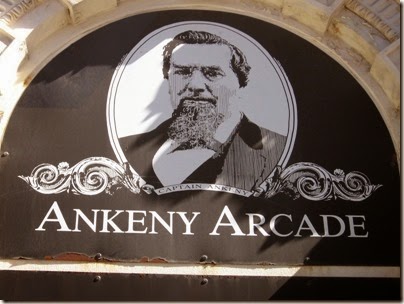
Portrait of Captain Ankeny on September 7, 2008
On the north side of Vine Street was the Bank of British Columbia, which was built in 1868 and occupied part of what is now Ankeny Square. On the south side was the Ankeny Block, built in 1869 by Captain Alexander P. Ankeny (1813-1891), an early developer who built numerous buildings of brick and cast iron in Portland. It was the largest brick building in Oregon when completed.
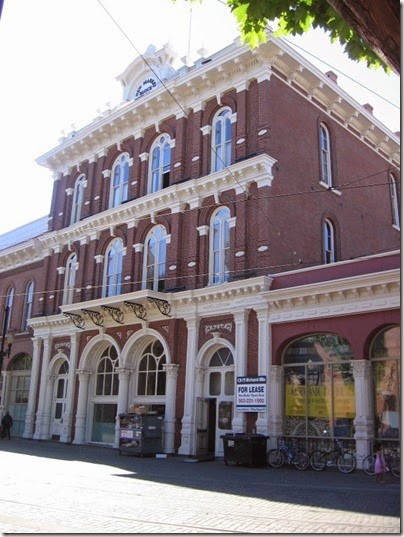
New Market Block on September 7, 2008
Across First Avenue to the west was the New Market Theater, built in 1872. A north wing was added in 1873, where Wells Fargo & Company operated from 1873 to 1894, and where the American Telephone and District Telegraph Company opened Portland's first telephone exchange on August 2, 1878. The Pioneer Switchboard had 5 operators handling calls for 32 customers. To the east across Front Avenue was the Cook Building, built in 1882.
Historical Photos:
New Market Block, May 13, 1962 (Salem Public Library)
New Market Block, May 13, 1962 (Salem Public Library)

A view of Vine Street from First Avenue during the flood of February 3, 1890. The Cook Building is in the background.
Oregon Historical Society Photograph
The most prominent feature of what is now Ankeny Square is the Skidmore Fountain, the oldest piece of public art in Portland.

Skidmore Fountain on September 7, 2008
When Stephen C. Skidmore, a Portland druggist and city councilman, died on January 18, 1883, he left $5,000 in his will for construction of a fountain.

Skidmore Fountain on September 7, 2008
The fountain of bronze and granite was sculpted by Olin Warner at a cost of $18,000; the additional funds came from three of Skidmore's friends.
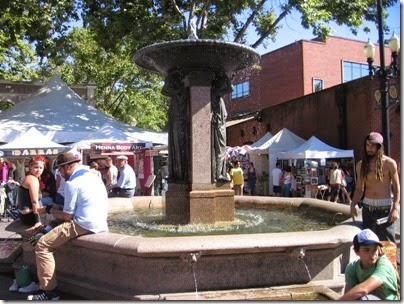
Skidmore Fountain on September 7, 2008
The fountain was completed in 1888.
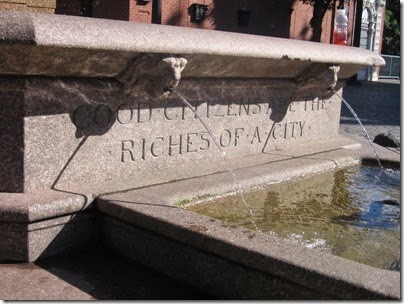
Skidmore Fountain on September 10, 2008
One of the inscriptions on the fountain, "Good citizens are the riches of a city," comes from the dedication speech given by attorney C.E.S. Wood, a member of the Fountain Committee.
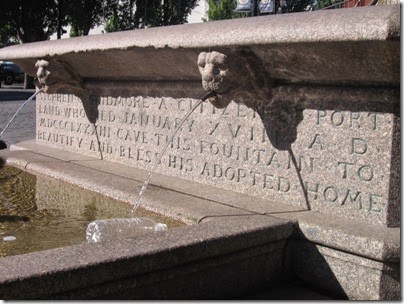
Skidmore Fountain on September 10, 2008
Another inscription reads: "Stephen C. Skidmore, a citizen of Portland who died January XVIII A.D. MDCCCLXXXIII gave this fountain to beautify and bless his adopted home."

Skidmore Fountain on September 7, 2008
The fountain was originally intended as a watering hole, and for nearly two decades tin cups were attached to the lions' heads for people to drink from.
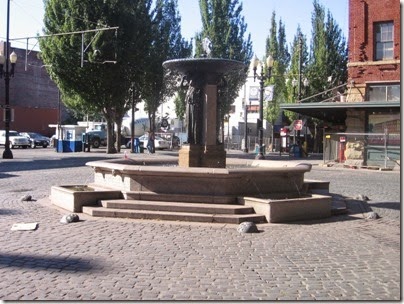
Skidmore Fountain on September 10, 2008
President Benjamin Harrison visited Portland in 1891. The presidential procession passed by the Skidmore Fountain, and reports of the day state the spectators crowded around the fountain at the procession passed.
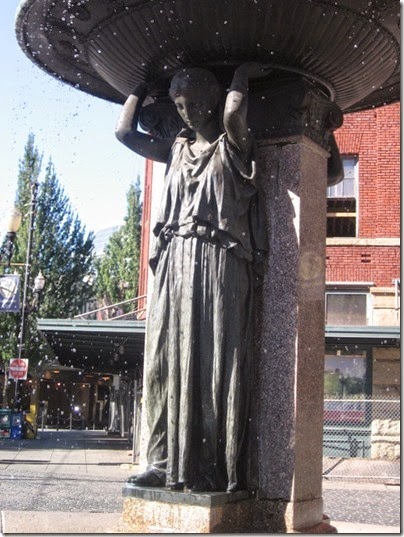
Skidmore Fountain on September 10, 2008
Historical Photos:
Skidmore Fountain, circa 1890 (Oregon Historical Society)
Skidmore Fountain, 1895 (Salem Public Library)
Skidmore Fountain, November 20, 1941 (Salem Public Library)
Skidmore Fountain, November 20, 1941 (Salem Public Library)
Skidmore Fountain, May 13, 1962 (Salem Public Library)
Skidmore Fountain, May 13, 1962 (Salem Public Library)
Skidmore Fountain, 1994 (Salem Public Library)
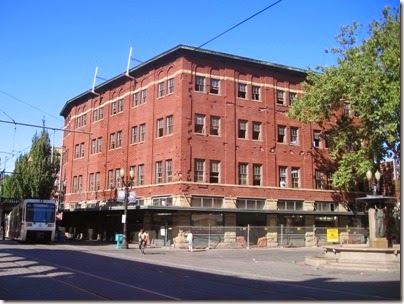
Packer-Scott Building on September 10, 2008
The Packer-Scott Building, also known as the Skidmore Fountain Building, was built in 1890.
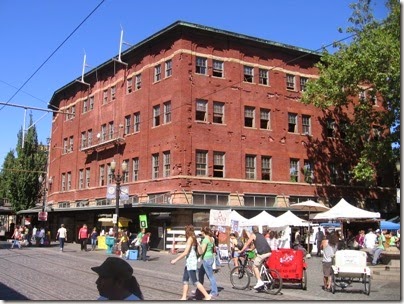
Packer-Scott Building on September 7, 2008
As of 2008, the Packer-Scott Building was being renovated to become the new home of Mercy Corps.
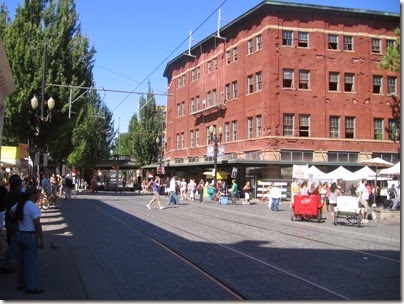
Packer-Scott Building on September 7, 2008
When the Skidmore Fountain was built, this was considered the center of Portland. Before the 1880s, Portland’s main commercial district was along the waterfront between Taylor and Burnside Streets. The introduction of horse-drawn streetcars on Third Avenue in 1880 and the arrival of the Northern Pacific Railway in 1883, started a building boom that began to move Portland’s downtown westward, away from the river.
As time went on and the cast iron buildings here aged, some of them were demolished, such as the Bank of British Columbia building in 1920. The demolition pace increased starting in the 1940s, with improvements to Front Avenue and the construction of Harbor Drive on the waterfront. The Ankeny Block was demolished around 1940, the Cook Building in 1942 and the New Market Theater's North Wing in 1956. The Oregon Historical Society and the Portland Friends of Cast Iron Architecture managed to save some of the cast iron elements from these demolished buildings.
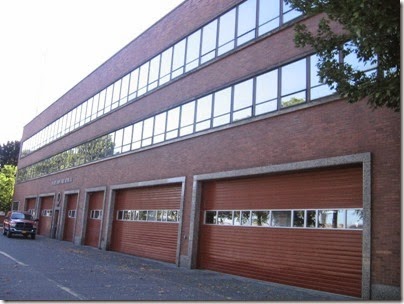
Portland Central Fire Station on September 10, 2008
Construction of Portland's new Central Fire Station began in 1949, facing Front Avenue between Ash Street and Vine Street.

Portland Central Fire Station on September 10, 2008
Designed by Jones and Marsh Architects, it was completed in 1951.
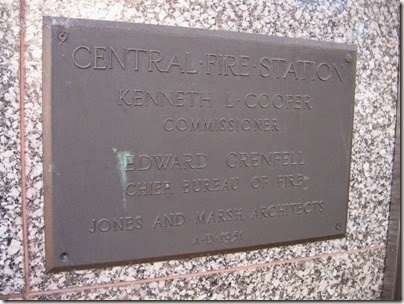
Portland Central Fire Station Cornerstone on September 10, 2008
The dedication plaque named City Commissioner Kenneth L. Cooper and Bureau of Fire Chief Edward Grenfell.
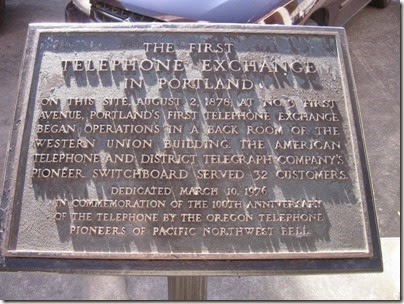
Telephone Exchange in Portland Plaque on September 10, 2008
In 1962, the Portland Junior Chamber of Commerce created a park on the site of the Bank of British Columbia Building and the vacated Vine Street, to enhance the surroundings of the Skidmore Fountain. On March 10, 1976, in honor of the 100th anniversary of the telephone, the Oregon Telephone Pioneers of Pacific Northwest Bell dedicated a plaque at the site of the New Market Theatre's North Wing, noting it as Portland's first telephone exchange.

Saturday Market – Old Town Sign on September 7, 2008
The Portland Saturday Market was established in 1974, and in 1976 it moved under the west end of the Burnside Bridge near the Skidmore Fountain, where it remained until May, 2009, when it moved to Tom McCall Waterfront Park.
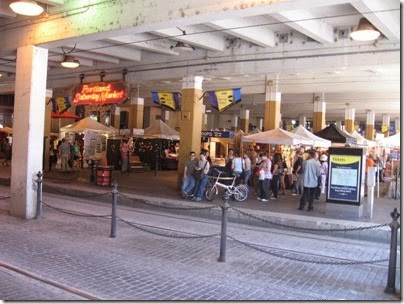
Portland Saturday Market on September 7, 2008
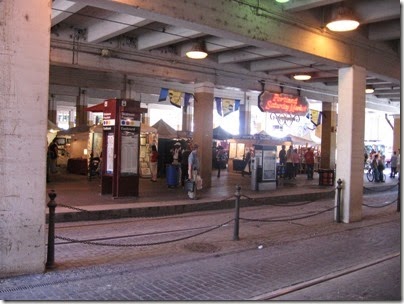
Portland Saturday Market on September 7, 2008
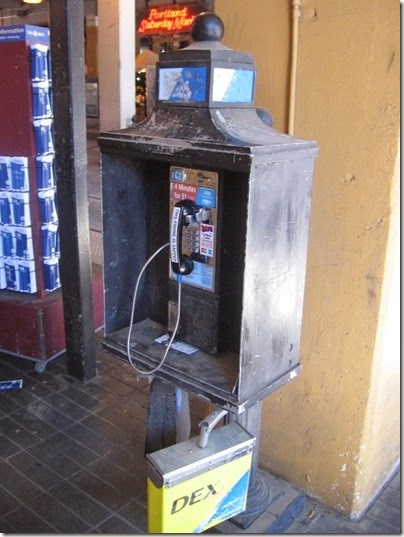
Phone at Skidmore Fountain MAX Station on September 7, 2008
This vintage telephone kiosk is located at the Saturday Market MAX station under the Burnside Bridge. Though equipped with a modern pay phone, the kiosk itself appears to be very old. The receiver of the modern phone has been tagged with a label reading "THIS PHONE IS TAPPED," that is obviously not officially approved.

Bud Clark Plaque on September 7, 2008
Near the Saturday Market MAX Station is a plaque bearing the following quote from J. E. Bud Clark, Mayor of Portland from 1985 to 1992:
The people of Portland are its greatest treasure.
Portland's greatness is in the livability of its neighborhoods. It is the people who make sure that Portland is clean, safe and prosperous. Our city is a jewel on the banks of the Willamette River and cultural and trading hub of the Columbia Basin.
If people hold fast to these priorities: family, business, and community, and if we are steadfast in preserving the quality of our environment, then Portland will remain one of the best places on Earth to live, to prosper, and to raise a new generation to carry on our traditions."
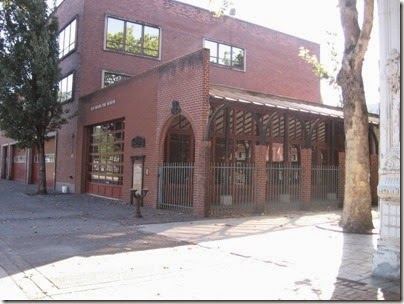
Jeff Morris Memorial Fire Museum on September 10, 2008
Next to Portland's Central Fire Station is the Jeff Morris Memorial Fire Museum, built in 1977 by the Friends of Jeff Morris Committee using public and private funds. Battalion Chief Jeff Morris pioneered fire prevention education in Portland until his death in 1974. The museum was dedicated in his memory in May 1986. It has since been relocated to the Belmont Firehouse. The space is now the Portland World Market.

Jeff Morris Memorial Fire Museum on September 10, 2008
The front wall of the museum building includes a bank vault door frame originally from the Ladd & Tilton Bank Building, which was at the southwest corner of First Avenue and Stark Street from 1868 to 1954. After the building was demolished, the exterior cast-iron elements were preserved, and were later used to enlarge Salem's similarly-styled Ladd & Bush Bank Building.

Ankeny Arcade on September 7, 2008
In 1978, the Skidmore/Old Town neighborhood was designated a National Landmark Historic District, and the Portland Development Commission built the Ankeny Arcade, dedicated to the memory of Captain Ankeny, on the site of the old Ankeny Block, using cast iron elements saved from demolished buildings. The column capitals here are from the McBreen Building, which was built in 1883 on the north side of Morrison Street between Third and Fourth Avenues by C.E. McBreen to house his crockery and glassware business. The McBreen Building was one of the first commercial building constructed west of Third Avenue. It was demolished in 1976.
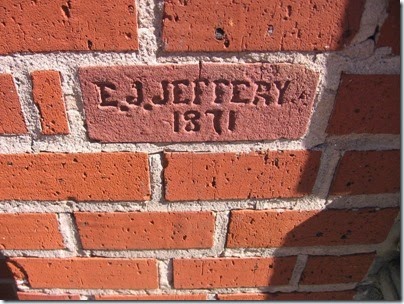
E.J. Jeffery Brick at the Ankeny Arcade on September 7, 2008
The Ankeny Arcade also includes a brick labeled “E.J. Jeffery 1871.” Edward James Jeffery came to Portland and manufactured bricks from 1867 to around 1895. He was an early user of machinery for making bricks instead of making them by hand. He was elected Sheriff of Multnomah County in 1872 and was also involved in the construction of railroad tunnels and city sewers.
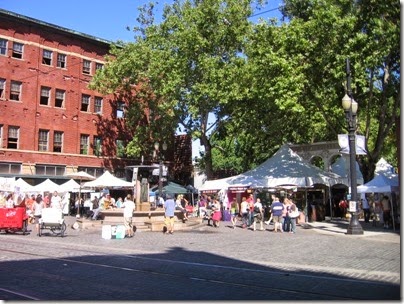
Ankeny Square on September 7, 2008
In 1984, the Bureau of Parks and Recreation redesigned the park created in 1962 for use as additional space for the Portland Saturday Market, which has been held under the Burnside Bridge since 1976, and named it Ankeny Square.

Ankeny Square on September 7, 2008
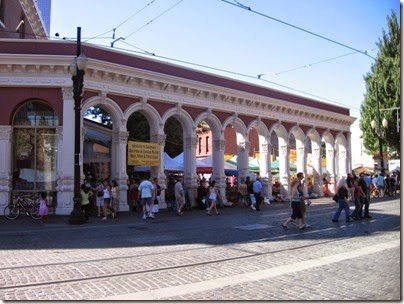
New Market Theater Colonnade on September 7, 2008
That same year, a colonnade consisting of cast-iron components salvaged from the North Wing of the New Market Theater by the Portland Friends of Cast Iron Architecture was erected on the site of the original building.
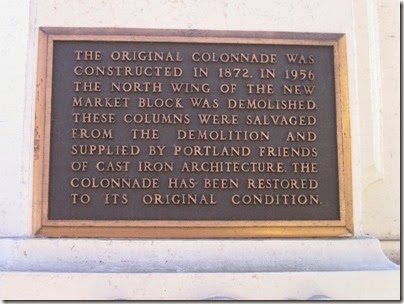
New Market Theater Colonnade Plaque on September 7, 2008
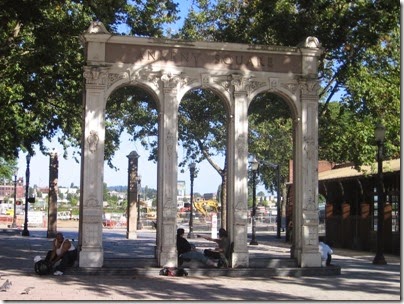
Ankeny Square Archway on September 10, 2008
This archway consists of cast iron elements from the Smith & Watson Building, which stood at the northeast corner of First Avenue and Main Street from 1883 to 1974. The building was designed by architect Warren H. Williams and built by Charles E. and Ferdinand C. Smith and J. Frank Watson, owners of the Smith and Watson Iron Works, which began as a machine shop in 1865 and began making decorative and architectural ironwork by 1869, eventually becoming the largest iron works in Portland with 90 employees and operating until after 1890. The iron works supplied the cast iron for its owners' building.
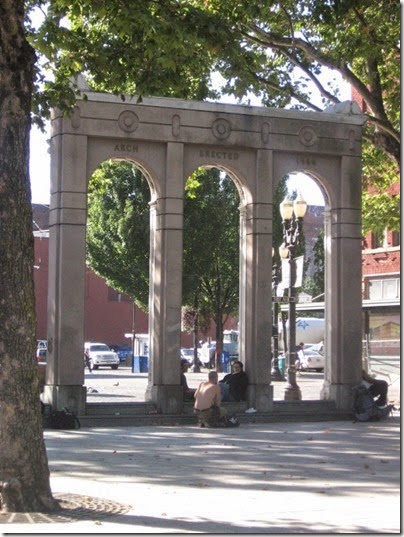
Ankeny Square Archway on September 10, 2008
After demolition, some of the cast iron components were saved by the Oregon Historical Society and the Portland Friends of Cast Iron Architecture. These components were used to construct this archway in 1986.
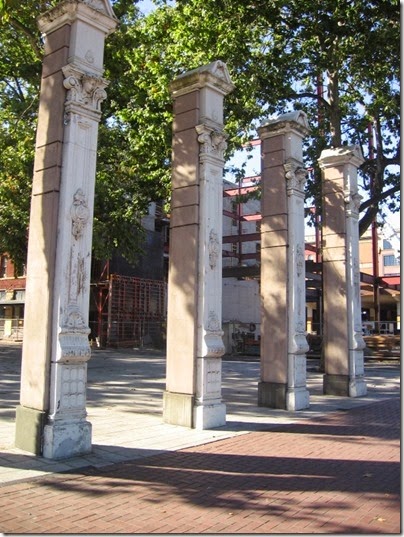
Ankeny Square Columns on September 10, 2008
Though not labeled, these columns along Front Avenue appear to have from the same building and erected at the same time as the archway.
Related Links:
Old Town Chinatown Neighborhood
Portland Saturday Market
Continue to Historic Old Town Buildings…

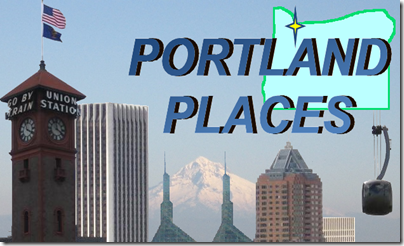
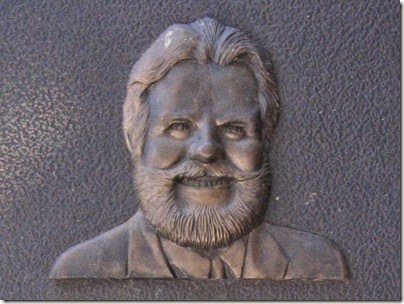
Great article! Nice photos! Visit also this site, where you can find all for car
ReplyDelete